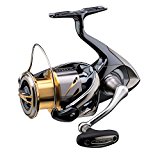European Bass (Sea Bass) River Fishing
Sea Bass can be caught at the mouth of rivers in relatively large numbers. In fact in the late 1990s, there was a report about a school of these fish in the River Blackwater, United Kingdom. It was estimated that there were some 10 million bass in this school based on its size and the estimated density.
Tides
Study tide times as you’ll want to fish the high tides, which bring in lots of baitfish. After all, it’s the baitfish that attract the Sea Bass.
Tackle
In order to improve your chances of landing a lunker European Bass, be sure to choose the right combination of reel, rod and line. Having the best lure helps little if you can’t detect a strike and set the hook. And if your rod and reel are not strong enough, you’ll loose more than your lure.
These bass can reach over 30lbs and have a ferocious fight. A light rod will snap and a light weight reel with have it’s gear strip.
Sea Bass Rods
- The Shimano Speedmaster Spin STC is a good solid saltwater rod that works both in the boat, on the beach and from the shore.
- The Daiwa Megaforce Baitcaster provides great sensitivity and provides a lot of control over the lure. When a large 20lb bass is on the hook, control is still smooth and assertive.
Lures
They are plenty of lures that work to catch European bass. But before we get into these types of lures, let’s go through the different food preferences for Sea Bass.
They have some 140 different foods that they’ll eat. Among the favorites, lugwords, ragworms, crustaceans, crayfish and baitfish.
Knowing what they like most, we then look to find what the current top food preference is and decide if we’re planning on fishing at night or during the day.
For daytime fishing, Berkley makes a lot of great lures such as the Pulse shads, kiddy sidwwinders sprats and the lunker city slug which looks like a lugworm.
Fly Fishing for Sea Bass
Flies also work very well for catching European Bass on rivers. We suggest trying the Turrall bass bug black hair, the Turrall gerbubble natural and the Turrall slinky black leech.
Fly-fishing for European Bass has been practiced for about 500 years and is one of the most enjoyable methods of catching them. Look for bass breaking the surface or feeding to know where to cast. Circling birds are a good sign that the bass are feeding and a good chance you’ll land a bass strike soon after casting.
A good way to catch their attention is to drag a dead sand eel and a mackerel skin behind the boat and it will immediately attract any European bass in the area. Now cast your fly, lure or bait into the disruption. Fly-fishing can also be practiced in estuaries and lagoons.


